MBA International Business: Lucky Lanka Milk's India Expansion Report
VerifiedAdded on 2022/09/02
|18
|3461
|20
Report
AI Summary
This report details the international business strategy of Lucky Lanka Milk, focusing on its expansion into the Indian market through a joint venture. It begins with an executive summary and table of contents, providing an overview of the company's background, selected product (Keerasa yogurt drink), and drivers for internationalization. The report then conducts a comprehensive analysis of the Indian macro-environment using the PESTEL framework, evaluates national competitiveness with the Porter Diamond Model, and assesses cultural aspects through the Hofstede framework. The 12C framework is used to determine the product's readiness. It also includes a Gantt chart and concludes with a discussion of the most appropriate entry and internationalization strategy for Lucky Lanka Milk. The report highlights the importance of understanding local market conditions, cultural differences, and competitive landscapes to achieve successful international expansion.

Running Head: MANAGEMENT 0
INTERNATIONAL BUSINESS
INTERNATIONAL BUSINESS
Paraphrase This Document
Need a fresh take? Get an instant paraphrase of this document with our AI Paraphraser
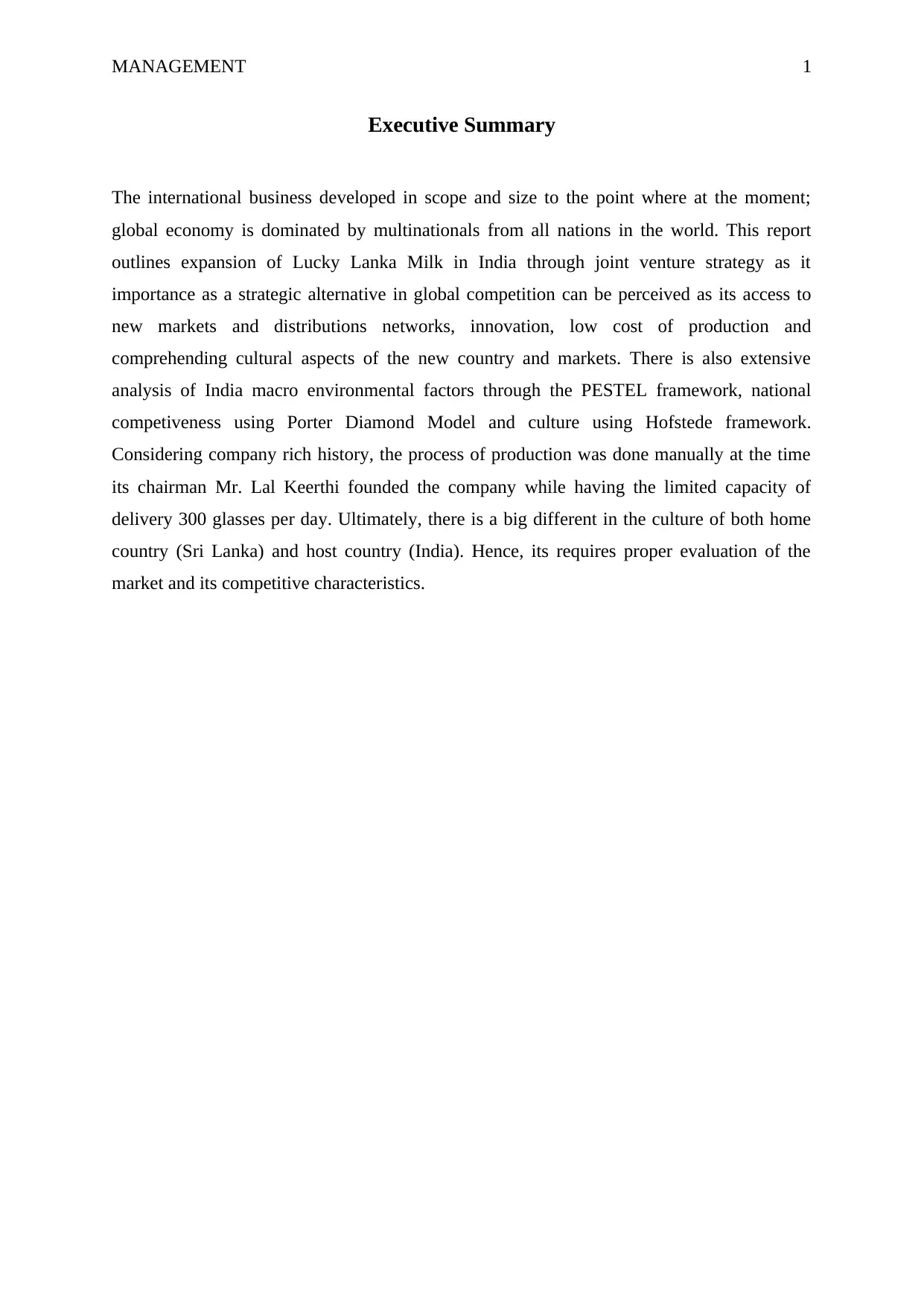
MANAGEMENT 1
Executive Summary
The international business developed in scope and size to the point where at the moment;
global economy is dominated by multinationals from all nations in the world. This report
outlines expansion of Lucky Lanka Milk in India through joint venture strategy as it
importance as a strategic alternative in global competition can be perceived as its access to
new markets and distributions networks, innovation, low cost of production and
comprehending cultural aspects of the new country and markets. There is also extensive
analysis of India macro environmental factors through the PESTEL framework, national
competiveness using Porter Diamond Model and culture using Hofstede framework.
Considering company rich history, the process of production was done manually at the time
its chairman Mr. Lal Keerthi founded the company while having the limited capacity of
delivery 300 glasses per day. Ultimately, there is a big different in the culture of both home
country (Sri Lanka) and host country (India). Hence, its requires proper evaluation of the
market and its competitive characteristics.
Executive Summary
The international business developed in scope and size to the point where at the moment;
global economy is dominated by multinationals from all nations in the world. This report
outlines expansion of Lucky Lanka Milk in India through joint venture strategy as it
importance as a strategic alternative in global competition can be perceived as its access to
new markets and distributions networks, innovation, low cost of production and
comprehending cultural aspects of the new country and markets. There is also extensive
analysis of India macro environmental factors through the PESTEL framework, national
competiveness using Porter Diamond Model and culture using Hofstede framework.
Considering company rich history, the process of production was done manually at the time
its chairman Mr. Lal Keerthi founded the company while having the limited capacity of
delivery 300 glasses per day. Ultimately, there is a big different in the culture of both home
country (Sri Lanka) and host country (India). Hence, its requires proper evaluation of the
market and its competitive characteristics.
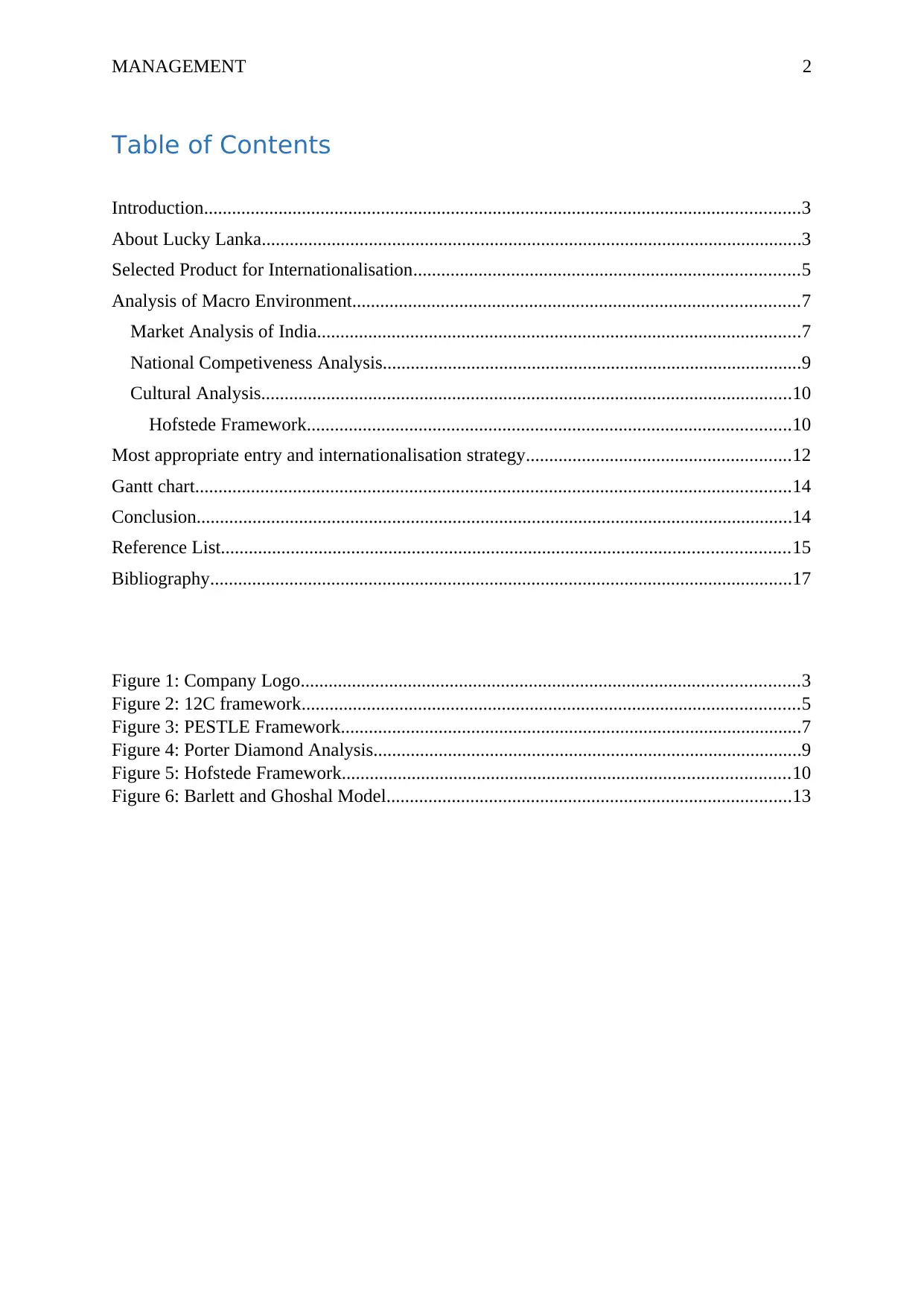
MANAGEMENT 2
Table of Contents
Introduction................................................................................................................................3
About Lucky Lanka....................................................................................................................3
Selected Product for Internationalisation...................................................................................5
Analysis of Macro Environment................................................................................................7
Market Analysis of India........................................................................................................7
National Competiveness Analysis..........................................................................................9
Cultural Analysis..................................................................................................................10
Hofstede Framework........................................................................................................10
Most appropriate entry and internationalisation strategy.........................................................12
Gantt chart................................................................................................................................14
Conclusion................................................................................................................................14
Reference List..........................................................................................................................15
Bibliography.............................................................................................................................17
Figure 1: Company Logo...........................................................................................................3
Figure 2: 12C framework...........................................................................................................5
Figure 3: PESTLE Framework...................................................................................................7
Figure 4: Porter Diamond Analysis............................................................................................9
Figure 5: Hofstede Framework................................................................................................10
Figure 6: Barlett and Ghoshal Model.......................................................................................13
Table of Contents
Introduction................................................................................................................................3
About Lucky Lanka....................................................................................................................3
Selected Product for Internationalisation...................................................................................5
Analysis of Macro Environment................................................................................................7
Market Analysis of India........................................................................................................7
National Competiveness Analysis..........................................................................................9
Cultural Analysis..................................................................................................................10
Hofstede Framework........................................................................................................10
Most appropriate entry and internationalisation strategy.........................................................12
Gantt chart................................................................................................................................14
Conclusion................................................................................................................................14
Reference List..........................................................................................................................15
Bibliography.............................................................................................................................17
Figure 1: Company Logo...........................................................................................................3
Figure 2: 12C framework...........................................................................................................5
Figure 3: PESTLE Framework...................................................................................................7
Figure 4: Porter Diamond Analysis............................................................................................9
Figure 5: Hofstede Framework................................................................................................10
Figure 6: Barlett and Ghoshal Model.......................................................................................13
⊘ This is a preview!⊘
Do you want full access?
Subscribe today to unlock all pages.

Trusted by 1+ million students worldwide
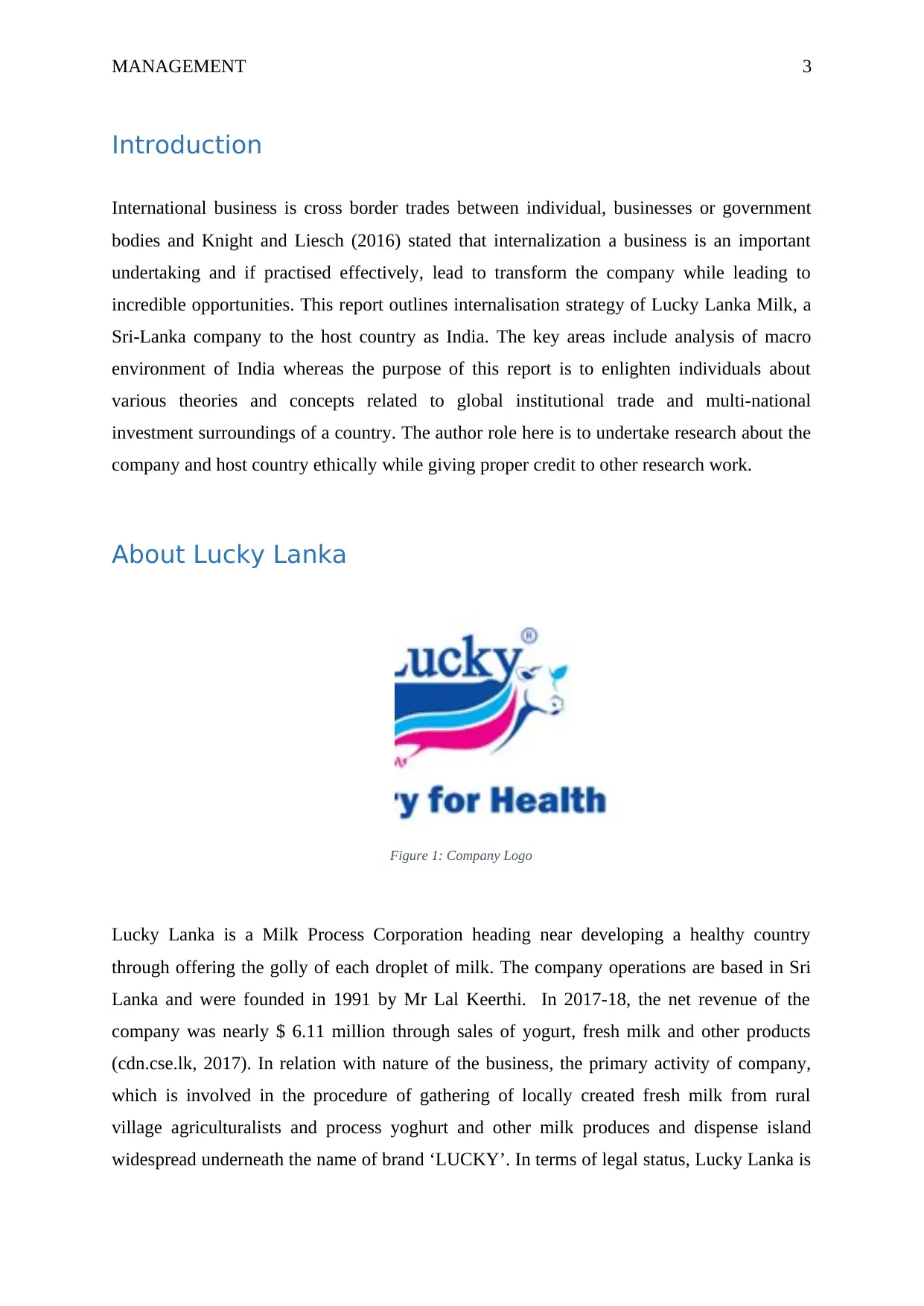
MANAGEMENT 3
Introduction
International business is cross border trades between individual, businesses or government
bodies and Knight and Liesch (2016) stated that internalization a business is an important
undertaking and if practised effectively, lead to transform the company while leading to
incredible opportunities. This report outlines internalisation strategy of Lucky Lanka Milk, a
Sri-Lanka company to the host country as India. The key areas include analysis of macro
environment of India whereas the purpose of this report is to enlighten individuals about
various theories and concepts related to global institutional trade and multi-national
investment surroundings of a country. The author role here is to undertake research about the
company and host country ethically while giving proper credit to other research work.
About Lucky Lanka
Figure 1: Company Logo
Lucky Lanka is a Milk Process Corporation heading near developing a healthy country
through offering the golly of each droplet of milk. The company operations are based in Sri
Lanka and were founded in 1991 by Mr Lal Keerthi. In 2017-18, the net revenue of the
company was nearly $ 6.11 million through sales of yogurt, fresh milk and other products
(cdn.cse.lk, 2017). In relation with nature of the business, the primary activity of company,
which is involved in the procedure of gathering of locally created fresh milk from rural
village agriculturalists and process yoghurt and other milk produces and dispense island
widespread underneath the name of brand ‘LUCKY’. In terms of legal status, Lucky Lanka is
Introduction
International business is cross border trades between individual, businesses or government
bodies and Knight and Liesch (2016) stated that internalization a business is an important
undertaking and if practised effectively, lead to transform the company while leading to
incredible opportunities. This report outlines internalisation strategy of Lucky Lanka Milk, a
Sri-Lanka company to the host country as India. The key areas include analysis of macro
environment of India whereas the purpose of this report is to enlighten individuals about
various theories and concepts related to global institutional trade and multi-national
investment surroundings of a country. The author role here is to undertake research about the
company and host country ethically while giving proper credit to other research work.
About Lucky Lanka
Figure 1: Company Logo
Lucky Lanka is a Milk Process Corporation heading near developing a healthy country
through offering the golly of each droplet of milk. The company operations are based in Sri
Lanka and were founded in 1991 by Mr Lal Keerthi. In 2017-18, the net revenue of the
company was nearly $ 6.11 million through sales of yogurt, fresh milk and other products
(cdn.cse.lk, 2017). In relation with nature of the business, the primary activity of company,
which is involved in the procedure of gathering of locally created fresh milk from rural
village agriculturalists and process yoghurt and other milk produces and dispense island
widespread underneath the name of brand ‘LUCKY’. In terms of legal status, Lucky Lanka is
Paraphrase This Document
Need a fresh take? Get an instant paraphrase of this document with our AI Paraphraser

MANAGEMENT 4
ruled by many laws and regulations comprising Corporate Act, CSR rules, SEC rules and
Inland Revenue Act. Lucky Lanka current chairman (Mr. Lal Keerthi) initiated the company
in 1991 as self-employment with a only cow and a supply of 100 glasses of milk
(luckylanka.lk, 2019). In relation to current competition, Pelwatte is their biggest competitor
in domestic market and increased competition in the market also follow Lucky Lanka much-
publicized IPO. However, the company has maintained its Uniqueness with broad product
range and innovation including range of yoghurt varieties, Ice Cream, Pasteurized, Sterilized
and UHT milk and various other products under ‘Lucky’ Brand with SLS certification. Lucky
Lanka has a vast opportunity to expand internationally company corporate structure and
governance will effectively also support it as the board of directors is devoted to ensuring
corporate integrity and proficiency in all its deeds. The company great market standing in Sri
Lanka, as well as their financial competiveness with total current assests $ 2.45 US million
(as of 2018), will help Lucky Lanka to expand internationalization (cdn.cse.lk, 2017).
Uppsala Model
Market Knowledge
Market Commitment
Market Knowledge
Market Commitment
And SO ON.
Leads to
Leads to
More
Leads to
More
It requires Lucky Lanka to
analyse culture and
characteristics of consumer
firm of India.
Here, Lucky Lanka requires
to decide the size of
investment in marketing and
personnel resources.
However before it,
uncertainty effect needs to
be analysed such as India
government policies and
declarations.
ruled by many laws and regulations comprising Corporate Act, CSR rules, SEC rules and
Inland Revenue Act. Lucky Lanka current chairman (Mr. Lal Keerthi) initiated the company
in 1991 as self-employment with a only cow and a supply of 100 glasses of milk
(luckylanka.lk, 2019). In relation to current competition, Pelwatte is their biggest competitor
in domestic market and increased competition in the market also follow Lucky Lanka much-
publicized IPO. However, the company has maintained its Uniqueness with broad product
range and innovation including range of yoghurt varieties, Ice Cream, Pasteurized, Sterilized
and UHT milk and various other products under ‘Lucky’ Brand with SLS certification. Lucky
Lanka has a vast opportunity to expand internationally company corporate structure and
governance will effectively also support it as the board of directors is devoted to ensuring
corporate integrity and proficiency in all its deeds. The company great market standing in Sri
Lanka, as well as their financial competiveness with total current assests $ 2.45 US million
(as of 2018), will help Lucky Lanka to expand internationalization (cdn.cse.lk, 2017).
Uppsala Model
Market Knowledge
Market Commitment
Market Knowledge
Market Commitment
And SO ON.
Leads to
Leads to
More
Leads to
More
It requires Lucky Lanka to
analyse culture and
characteristics of consumer
firm of India.
Here, Lucky Lanka requires
to decide the size of
investment in marketing and
personnel resources.
However before it,
uncertainty effect needs to
be analysed such as India
government policies and
declarations.
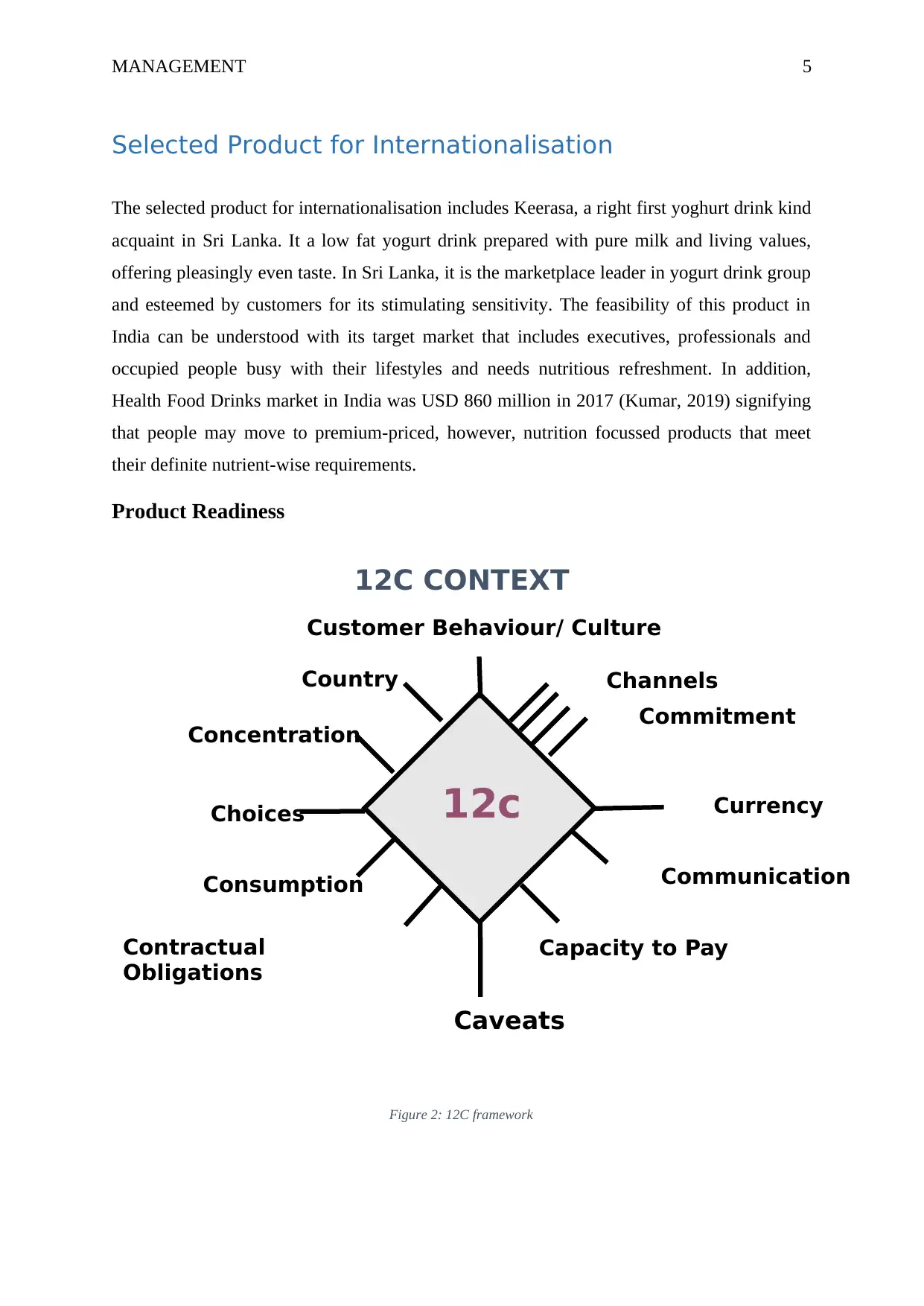
MANAGEMENT 5
Selected Product for Internationalisation
The selected product for internationalisation includes Keerasa, a right first yoghurt drink kind
acquaint in Sri Lanka. It a low fat yogurt drink prepared with pure milk and living values,
offering pleasingly even taste. In Sri Lanka, it is the marketplace leader in yogurt drink group
and esteemed by customers for its stimulating sensitivity. The feasibility of this product in
India can be understood with its target market that includes executives, professionals and
occupied people busy with their lifestyles and needs nutritious refreshment. In addition,
Health Food Drinks market in India was USD 860 million in 2017 (Kumar, 2019) signifying
that people may move to premium-priced, however, nutrition focussed products that meet
their definite nutrient-wise requirements.
Product Readiness
Figure 2: 12C framework
12C CONTEXT
Country
Customer Behaviour/ Culture
Concentration
Channels
Commitment
Choices
Caveats
Consumption Communication
Currency
Contractual
Obligations
Capacity to Pay
12c
Selected Product for Internationalisation
The selected product for internationalisation includes Keerasa, a right first yoghurt drink kind
acquaint in Sri Lanka. It a low fat yogurt drink prepared with pure milk and living values,
offering pleasingly even taste. In Sri Lanka, it is the marketplace leader in yogurt drink group
and esteemed by customers for its stimulating sensitivity. The feasibility of this product in
India can be understood with its target market that includes executives, professionals and
occupied people busy with their lifestyles and needs nutritious refreshment. In addition,
Health Food Drinks market in India was USD 860 million in 2017 (Kumar, 2019) signifying
that people may move to premium-priced, however, nutrition focussed products that meet
their definite nutrient-wise requirements.
Product Readiness
Figure 2: 12C framework
12C CONTEXT
Country
Customer Behaviour/ Culture
Concentration
Channels
Commitment
Choices
Caveats
Consumption Communication
Currency
Contractual
Obligations
Capacity to Pay
12c
⊘ This is a preview!⊘
Do you want full access?
Subscribe today to unlock all pages.

Trusted by 1+ million students worldwide
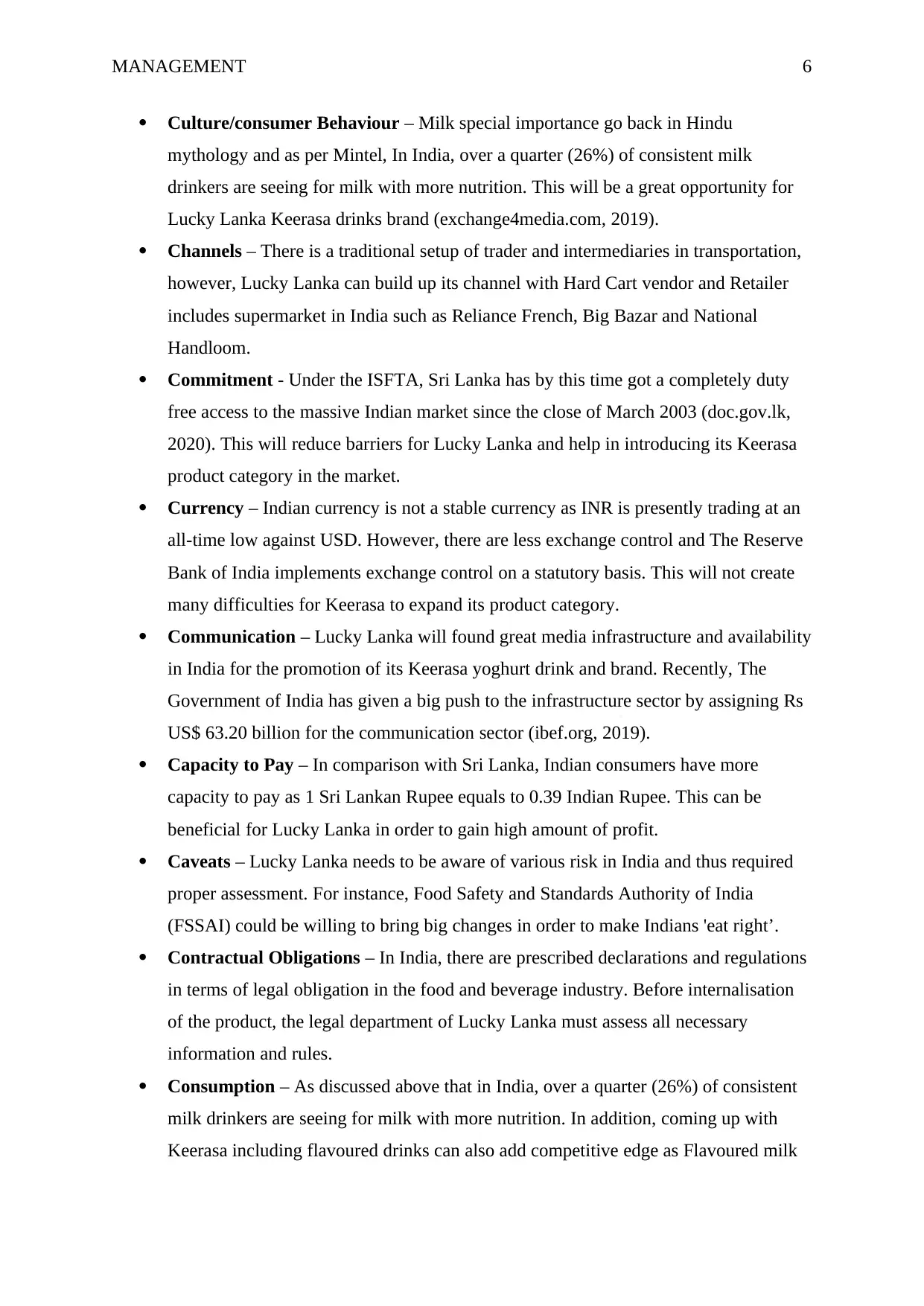
MANAGEMENT 6
Culture/consumer Behaviour – Milk special importance go back in Hindu
mythology and as per Mintel, In India, over a quarter (26%) of consistent milk
drinkers are seeing for milk with more nutrition. This will be a great opportunity for
Lucky Lanka Keerasa drinks brand (exchange4media.com, 2019).
Channels – There is a traditional setup of trader and intermediaries in transportation,
however, Lucky Lanka can build up its channel with Hard Cart vendor and Retailer
includes supermarket in India such as Reliance French, Big Bazar and National
Handloom.
Commitment - Under the ISFTA, Sri Lanka has by this time got a completely duty
free access to the massive Indian market since the close of March 2003 (doc.gov.lk,
2020). This will reduce barriers for Lucky Lanka and help in introducing its Keerasa
product category in the market.
Currency – Indian currency is not a stable currency as INR is presently trading at an
all-time low against USD. However, there are less exchange control and The Reserve
Bank of India implements exchange control on a statutory basis. This will not create
many difficulties for Keerasa to expand its product category.
Communication – Lucky Lanka will found great media infrastructure and availability
in India for the promotion of its Keerasa yoghurt drink and brand. Recently, The
Government of India has given a big push to the infrastructure sector by assigning Rs
US$ 63.20 billion for the communication sector (ibef.org, 2019).
Capacity to Pay – In comparison with Sri Lanka, Indian consumers have more
capacity to pay as 1 Sri Lankan Rupee equals to 0.39 Indian Rupee. This can be
beneficial for Lucky Lanka in order to gain high amount of profit.
Caveats – Lucky Lanka needs to be aware of various risk in India and thus required
proper assessment. For instance, Food Safety and Standards Authority of India
(FSSAI) could be willing to bring big changes in order to make Indians 'eat right’.
Contractual Obligations – In India, there are prescribed declarations and regulations
in terms of legal obligation in the food and beverage industry. Before internalisation
of the product, the legal department of Lucky Lanka must assess all necessary
information and rules.
Consumption – As discussed above that in India, over a quarter (26%) of consistent
milk drinkers are seeing for milk with more nutrition. In addition, coming up with
Keerasa including flavoured drinks can also add competitive edge as Flavoured milk
Culture/consumer Behaviour – Milk special importance go back in Hindu
mythology and as per Mintel, In India, over a quarter (26%) of consistent milk
drinkers are seeing for milk with more nutrition. This will be a great opportunity for
Lucky Lanka Keerasa drinks brand (exchange4media.com, 2019).
Channels – There is a traditional setup of trader and intermediaries in transportation,
however, Lucky Lanka can build up its channel with Hard Cart vendor and Retailer
includes supermarket in India such as Reliance French, Big Bazar and National
Handloom.
Commitment - Under the ISFTA, Sri Lanka has by this time got a completely duty
free access to the massive Indian market since the close of March 2003 (doc.gov.lk,
2020). This will reduce barriers for Lucky Lanka and help in introducing its Keerasa
product category in the market.
Currency – Indian currency is not a stable currency as INR is presently trading at an
all-time low against USD. However, there are less exchange control and The Reserve
Bank of India implements exchange control on a statutory basis. This will not create
many difficulties for Keerasa to expand its product category.
Communication – Lucky Lanka will found great media infrastructure and availability
in India for the promotion of its Keerasa yoghurt drink and brand. Recently, The
Government of India has given a big push to the infrastructure sector by assigning Rs
US$ 63.20 billion for the communication sector (ibef.org, 2019).
Capacity to Pay – In comparison with Sri Lanka, Indian consumers have more
capacity to pay as 1 Sri Lankan Rupee equals to 0.39 Indian Rupee. This can be
beneficial for Lucky Lanka in order to gain high amount of profit.
Caveats – Lucky Lanka needs to be aware of various risk in India and thus required
proper assessment. For instance, Food Safety and Standards Authority of India
(FSSAI) could be willing to bring big changes in order to make Indians 'eat right’.
Contractual Obligations – In India, there are prescribed declarations and regulations
in terms of legal obligation in the food and beverage industry. Before internalisation
of the product, the legal department of Lucky Lanka must assess all necessary
information and rules.
Consumption – As discussed above that in India, over a quarter (26%) of consistent
milk drinkers are seeing for milk with more nutrition. In addition, coming up with
Keerasa including flavoured drinks can also add competitive edge as Flavoured milk
Paraphrase This Document
Need a fresh take? Get an instant paraphrase of this document with our AI Paraphraser

MANAGEMENT 7
in India is still not a group that likes mainstream intake in India
(exchange4media.com, 2019).
Choices – Introducing Keerasa with different flavours can also benefit company to
earn more profit in India as due to less choice in this category.
Concentration – Indian is on the seventh rank in terms of largest country for area.
This shows that Lucky Lanka shall have great growth opportunity in India however,
the company requires to assess and prioritize market very carefully.
Country – The GDP growth rate is currently on a declining trend derives on 2.6 lakh
crores USD as of 2017 (pib.gov.in, 2018). However, India population perceives
drinking milk on a positive note and it makes up 81 % of India's 1.3 billion people.
Analysis of Macro Environment
Market Analysis of India
Figure 3: PESTLE Framework
Political Factors – The political environment of India is stable and also have
foreseeable policy framework and this marks India an “attractive” investment target
EconomicPolitical
Social Technological
LegalEnvironmental
in India is still not a group that likes mainstream intake in India
(exchange4media.com, 2019).
Choices – Introducing Keerasa with different flavours can also benefit company to
earn more profit in India as due to less choice in this category.
Concentration – Indian is on the seventh rank in terms of largest country for area.
This shows that Lucky Lanka shall have great growth opportunity in India however,
the company requires to assess and prioritize market very carefully.
Country – The GDP growth rate is currently on a declining trend derives on 2.6 lakh
crores USD as of 2017 (pib.gov.in, 2018). However, India population perceives
drinking milk on a positive note and it makes up 81 % of India's 1.3 billion people.
Analysis of Macro Environment
Market Analysis of India
Figure 3: PESTLE Framework
Political Factors – The political environment of India is stable and also have
foreseeable policy framework and this marks India an “attractive” investment target
EconomicPolitical
Social Technological
LegalEnvironmental
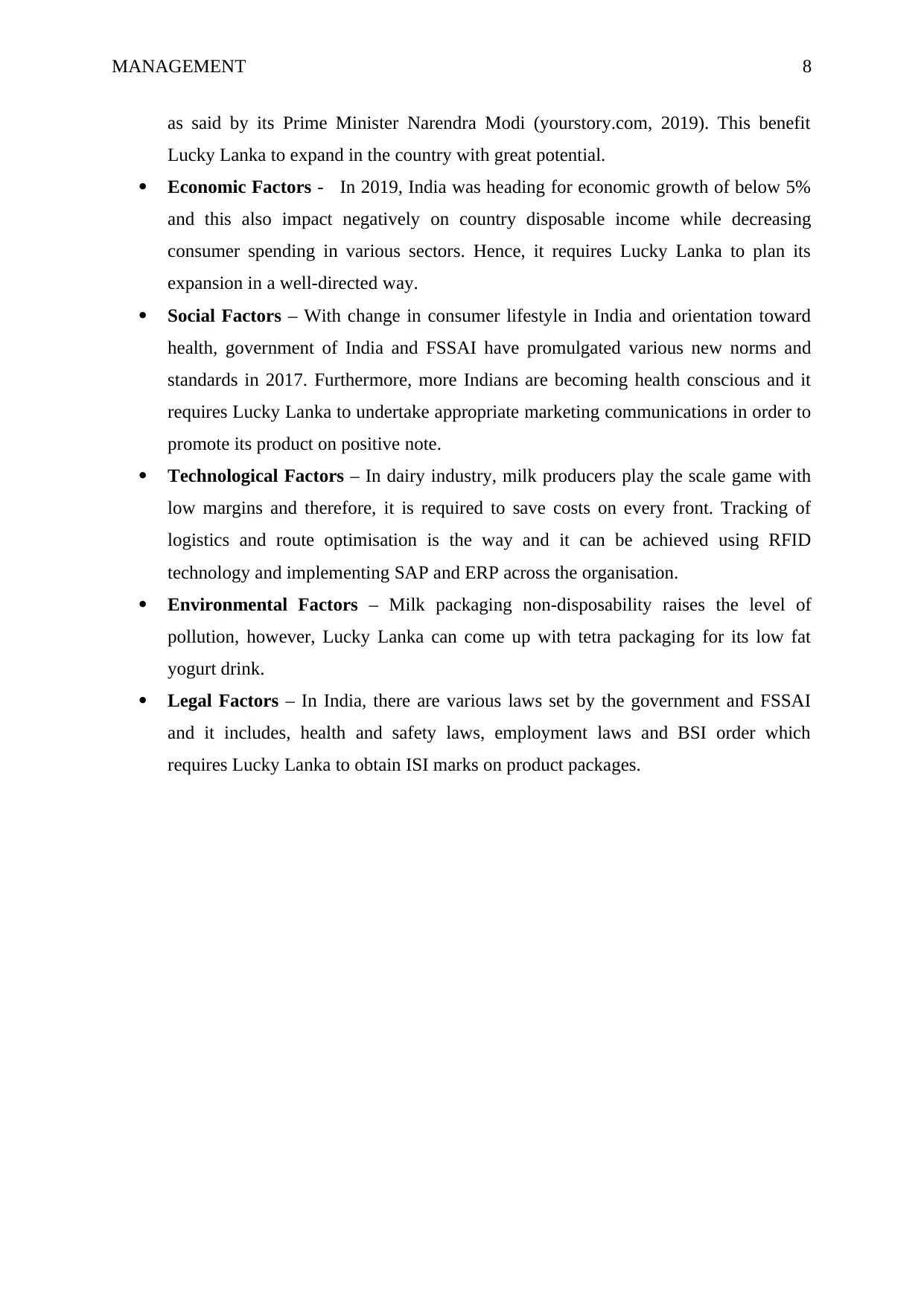
MANAGEMENT 8
as said by its Prime Minister Narendra Modi (yourstory.com, 2019). This benefit
Lucky Lanka to expand in the country with great potential.
Economic Factors - In 2019, India was heading for economic growth of below 5%
and this also impact negatively on country disposable income while decreasing
consumer spending in various sectors. Hence, it requires Lucky Lanka to plan its
expansion in a well-directed way.
Social Factors – With change in consumer lifestyle in India and orientation toward
health, government of India and FSSAI have promulgated various new norms and
standards in 2017. Furthermore, more Indians are becoming health conscious and it
requires Lucky Lanka to undertake appropriate marketing communications in order to
promote its product on positive note.
Technological Factors – In dairy industry, milk producers play the scale game with
low margins and therefore, it is required to save costs on every front. Tracking of
logistics and route optimisation is the way and it can be achieved using RFID
technology and implementing SAP and ERP across the organisation.
Environmental Factors – Milk packaging non-disposability raises the level of
pollution, however, Lucky Lanka can come up with tetra packaging for its low fat
yogurt drink.
Legal Factors – In India, there are various laws set by the government and FSSAI
and it includes, health and safety laws, employment laws and BSI order which
requires Lucky Lanka to obtain ISI marks on product packages.
as said by its Prime Minister Narendra Modi (yourstory.com, 2019). This benefit
Lucky Lanka to expand in the country with great potential.
Economic Factors - In 2019, India was heading for economic growth of below 5%
and this also impact negatively on country disposable income while decreasing
consumer spending in various sectors. Hence, it requires Lucky Lanka to plan its
expansion in a well-directed way.
Social Factors – With change in consumer lifestyle in India and orientation toward
health, government of India and FSSAI have promulgated various new norms and
standards in 2017. Furthermore, more Indians are becoming health conscious and it
requires Lucky Lanka to undertake appropriate marketing communications in order to
promote its product on positive note.
Technological Factors – In dairy industry, milk producers play the scale game with
low margins and therefore, it is required to save costs on every front. Tracking of
logistics and route optimisation is the way and it can be achieved using RFID
technology and implementing SAP and ERP across the organisation.
Environmental Factors – Milk packaging non-disposability raises the level of
pollution, however, Lucky Lanka can come up with tetra packaging for its low fat
yogurt drink.
Legal Factors – In India, there are various laws set by the government and FSSAI
and it includes, health and safety laws, employment laws and BSI order which
requires Lucky Lanka to obtain ISI marks on product packages.
⊘ This is a preview!⊘
Do you want full access?
Subscribe today to unlock all pages.

Trusted by 1+ million students worldwide

MANAGEMENT 9
National Competiveness Analysis
Figure 4: Porter Diamond Analysis
Chance – In relation to Lucky Lanka, this factor will not lead to such advantage or
disadvantage as it includes some random events when and where fundamental
scientific breakthroughs occur including war and natural disaster.
Firm Strategy, Structure and Competition – In the business corporate structure and
governance, the board of directors is dedicated to ensuring corporate reliability and
competence in all its undertakings and this will effectively support firm strategy to
facilitate innovation and changes.
Factor Conditions – Attractive and economic innovation will definitely help Lucky
Lanka to expand its footprints in India considering also as stated above its total
current assests $ 2.45 US million (as of 2018).
Demand Conditions – As per mitsui.com (2017), there is a future trend of growing
demand for dairy and milk product in India and with adding of different flavour to
their yoghurt drink brand, the company can definitely gain competitive edge in the
industry.
Firm
Strategy,
Structure
and Rivalry
Chance
Government Factor
conditions
Related and
Supporting
Industries
Demand
Conditions
National Competiveness Analysis
Figure 4: Porter Diamond Analysis
Chance – In relation to Lucky Lanka, this factor will not lead to such advantage or
disadvantage as it includes some random events when and where fundamental
scientific breakthroughs occur including war and natural disaster.
Firm Strategy, Structure and Competition – In the business corporate structure and
governance, the board of directors is dedicated to ensuring corporate reliability and
competence in all its undertakings and this will effectively support firm strategy to
facilitate innovation and changes.
Factor Conditions – Attractive and economic innovation will definitely help Lucky
Lanka to expand its footprints in India considering also as stated above its total
current assests $ 2.45 US million (as of 2018).
Demand Conditions – As per mitsui.com (2017), there is a future trend of growing
demand for dairy and milk product in India and with adding of different flavour to
their yoghurt drink brand, the company can definitely gain competitive edge in the
industry.
Firm
Strategy,
Structure
and Rivalry
Chance
Government Factor
conditions
Related and
Supporting
Industries
Demand
Conditions
Paraphrase This Document
Need a fresh take? Get an instant paraphrase of this document with our AI Paraphraser
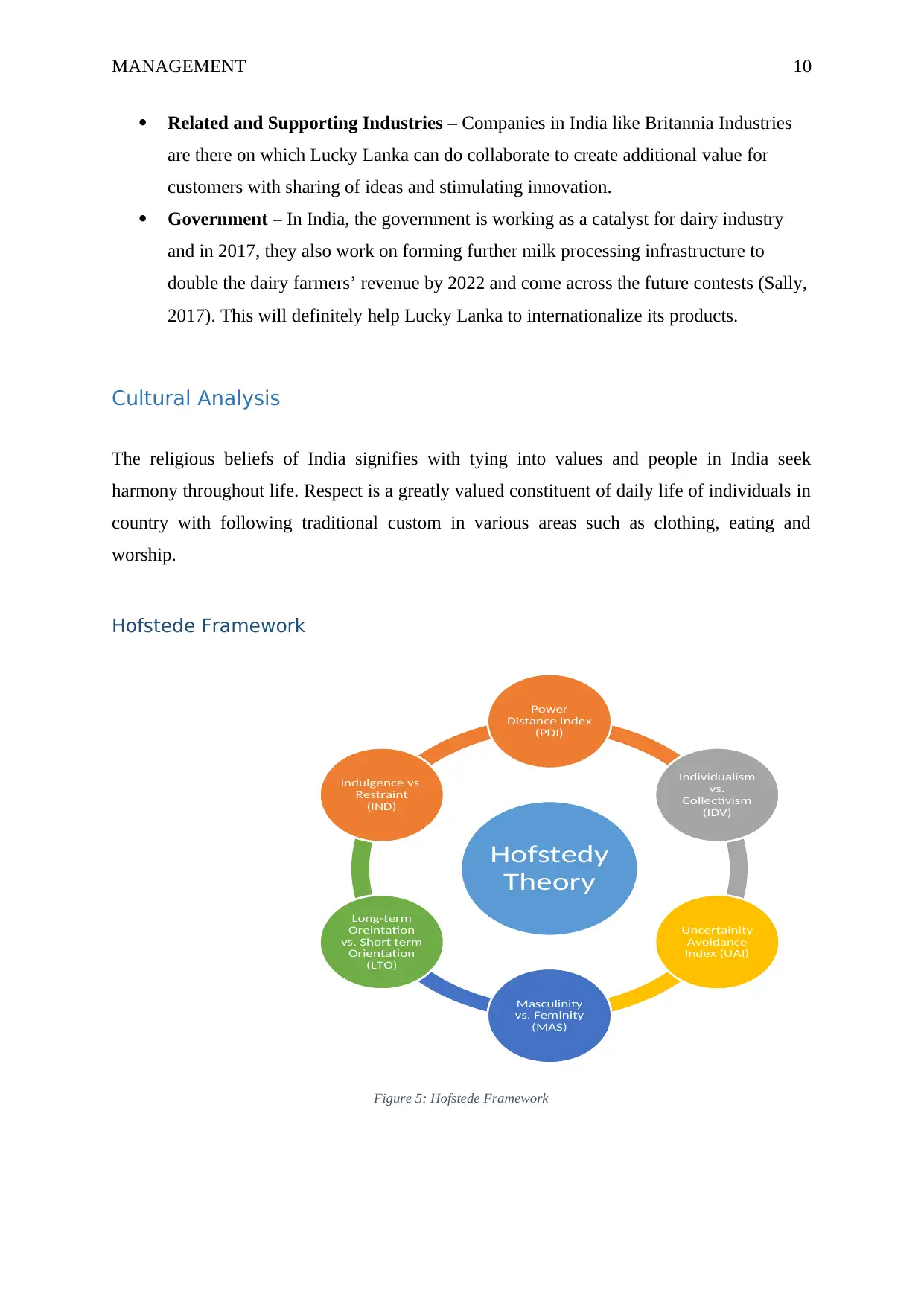
MANAGEMENT 10
Related and Supporting Industries – Companies in India like Britannia Industries
are there on which Lucky Lanka can do collaborate to create additional value for
customers with sharing of ideas and stimulating innovation.
Government – In India, the government is working as a catalyst for dairy industry
and in 2017, they also work on forming further milk processing infrastructure to
double the dairy farmers’ revenue by 2022 and come across the future contests (Sally,
2017). This will definitely help Lucky Lanka to internationalize its products.
Cultural Analysis
The religious beliefs of India signifies with tying into values and people in India seek
harmony throughout life. Respect is a greatly valued constituent of daily life of individuals in
country with following traditional custom in various areas such as clothing, eating and
worship.
Hofstede Framework
Figure 5: Hofstede Framework
Hofstedy
Theory
Power
Distance Index
(PDI)
Individualism
vs.
Collectivism
(IDV)
Uncertainity
Avoidance
Index (UAI)
Masculinity
vs. Feminity
(MAS)
Long-term
Oreintation
vs. Short term
Orientation
(LTO)
Indulgence vs.
Restraint
(IND)
Related and Supporting Industries – Companies in India like Britannia Industries
are there on which Lucky Lanka can do collaborate to create additional value for
customers with sharing of ideas and stimulating innovation.
Government – In India, the government is working as a catalyst for dairy industry
and in 2017, they also work on forming further milk processing infrastructure to
double the dairy farmers’ revenue by 2022 and come across the future contests (Sally,
2017). This will definitely help Lucky Lanka to internationalize its products.
Cultural Analysis
The religious beliefs of India signifies with tying into values and people in India seek
harmony throughout life. Respect is a greatly valued constituent of daily life of individuals in
country with following traditional custom in various areas such as clothing, eating and
worship.
Hofstede Framework
Figure 5: Hofstede Framework
Hofstedy
Theory
Power
Distance Index
(PDI)
Individualism
vs.
Collectivism
(IDV)
Uncertainity
Avoidance
Index (UAI)
Masculinity
vs. Feminity
(MAS)
Long-term
Oreintation
vs. Short term
Orientation
(LTO)
Indulgence vs.
Restraint
(IND)

MANAGEMENT 11
(Country
/
Dimensio
n)
PDI IDV UAI MAS LTO IND
India 77 48 40 56 51 26
(Perceived
as
appreciatio
n for
hierarchy
where
employees
can
assume to
be engaged
evidently
as to their
meanings)
(The society
in country
have both
collective
and
individualist
(due to
dominance
of religion
i.e.
Hinduism)
traits)
(Signifying
a medium
low
preference
for evading
uncertainty)
(India is
considered
as
Masculine
society
where it is
driven by
achieveme
nt,
competitio
n and
success)
(It shows
that a
dominant
preference
in the
culture of
country
cannot be
determine
d,
however,
nations
such as
India have
a good
tolerance
for
religious
visions in
the globe)
(It implies
that it is a
culture of
Restraint)
(Country
/
Dimension
)
PDI IDV UAI MAS LTO IND
Sri Lanka 80 35 45 10 45 -
(It shows that
Sri Lanka is a
(The
societ
(Signifying
not a strong
(Signifyin
g country
(It shows
that Sri
(In this
context,
(Country
/
Dimensio
n)
PDI IDV UAI MAS LTO IND
India 77 48 40 56 51 26
(Perceived
as
appreciatio
n for
hierarchy
where
employees
can
assume to
be engaged
evidently
as to their
meanings)
(The society
in country
have both
collective
and
individualist
(due to
dominance
of religion
i.e.
Hinduism)
traits)
(Signifying
a medium
low
preference
for evading
uncertainty)
(India is
considered
as
Masculine
society
where it is
driven by
achieveme
nt,
competitio
n and
success)
(It shows
that a
dominant
preference
in the
culture of
country
cannot be
determine
d,
however,
nations
such as
India have
a good
tolerance
for
religious
visions in
the globe)
(It implies
that it is a
culture of
Restraint)
(Country
/
Dimension
)
PDI IDV UAI MAS LTO IND
Sri Lanka 80 35 45 10 45 -
(It shows that
Sri Lanka is a
(The
societ
(Signifying
not a strong
(Signifyin
g country
(It shows
that Sri
(In this
context,
⊘ This is a preview!⊘
Do you want full access?
Subscribe today to unlock all pages.

Trusted by 1+ million students worldwide
1 out of 18
Related Documents
Your All-in-One AI-Powered Toolkit for Academic Success.
+13062052269
info@desklib.com
Available 24*7 on WhatsApp / Email
![[object Object]](/_next/static/media/star-bottom.7253800d.svg)
Unlock your academic potential
Copyright © 2020–2025 A2Z Services. All Rights Reserved. Developed and managed by ZUCOL.





